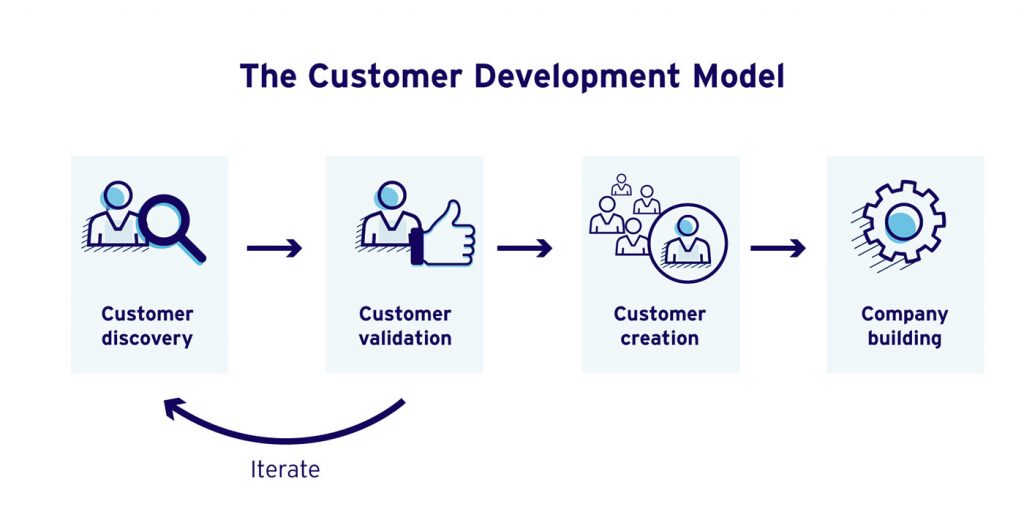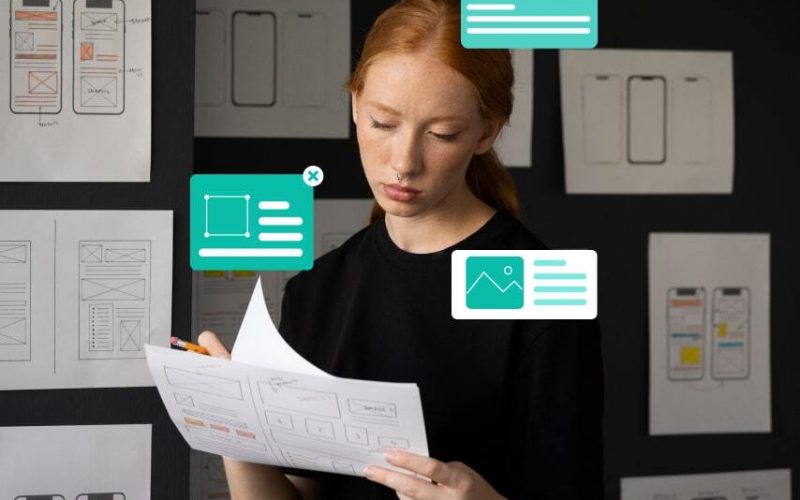As a product creator or a business owner, you should already know that building successful products isn’t merely about having a great idea. In fact, that’s only a small part of the job.
Successful products are about understanding your customers, what they need, and making sure your product meets those needs.
This is where the concept of customer development comes barging in. Customer development is essentially a process aimed at understanding your audience and their preferences. It’s a series of activities to gather information using which you are able to create successful products your customers want.
In this article, we’ll dive into all aspects of doing customer development right – from uncovering the larger scope of customer development to how to gather the necessary information and how to use it to create products that sell.
What Is Customer Development and What Are Its Goals?
Customer Development Model (CDM) is a framework first mentioned by Steve Blank in his book The Four Steps to the Epiphany. The customer development process consists of four steps:
- Customer discovery
- Customer validation
- Customer creation
- Company building

The first two stages operate in a loop – discover a need, validate it, make changes and consider “pivoting” if necessary – all until you reach a good product-market fit. The last two refer to growing the company once you’ve found what it is your target audience wants and how you can give it to them.
So in a nutshell, customer development is a series of activities targeted at understanding your customers’ needs, validating your hypotheses, and uncovering problems and potential risks before launching (or even fully building) your products.
The process involves engaging with your potential customers through multiple means with the purpose of gaining insights about their behaviors, likes and dislikes, and pain points.
The most comprehensive way of conducting customer development for new products is Prelaunch.com, but we’ll discuss the step-by-step process later in the article. For now, let’s talk about the main goals of customer development.
- Identifying customer needs and pain points
Engaging with potential buyers gives you access to valuable insights into what problems they are facing at the moment and what needs they have that are currently unmet by existing players in the market.
- Validating assumptions and hypotheses
To avoid investing time, finances, and human capital into building a product only for it to fail later, it’s crucial to validate all your assumptions about the target market. With proper customer development practices in place, you can test all your hypotheses and gain actionable feedback on the ways you can improve the product before it gets to the intended audience.
- Building products that solve a real problem for customers
Once you understand what it is that your customers want, you get a clear roadmap of how to build a product that is going to address their pain points and actually solve their problems.
- Discovering and reducing risks
Validating your hypotheses gives you information on the potential risks you might face, helping you to act on these insights and eliminate these risks. No creator wants to launch a product that no one wants and waste resources.
To sum up, the goal of customer development is to ultimately build products your target market has a real need for, ensuring customer satisfaction and loyalty as a result.
The Importance and Benefits of Customer Development
Now that we’ve gone over the goals of customer development, it’s time to dive into why it’s so important for any creator or business owner as well as the benefits it provides. customer development is what guarantees your success along with its longevity in a constantly evolving market.
- Reduce product development risks
customer development helps creators identify the potential or existing flaws in the product based on the actual target market’s insights. This information then helps reduce risks associated with investing resources into areas of product development or features that aren’t necessarily valuable for the intended market.
- Minimize the waste of resources
Building up on the first point, creating something the intended user doesn’t need results in a waste of valuable resources like time, money, and human capital. customer development mitigates this by exposing early on where the company’s focus should be, so all resources are invested efficiently and in alignment with customer needs.
💡 Data-Driven Customer Insights for Smarter Decisions
Instead of relying on gut feelings, use Prelaunch’s Customer Insights to understand how users interact with your product.
- Maximize customer satisfaction and loyalty
Every business owner knows that the success of the company relies on the satisfaction of its customers. Knowing what your users need and delivering just that helps creators increase the number of satisfied customers and brand loyalty, which ultimately results in word-of-mouth recommendations, repeat buyers, referrals, and a great reputation.
- Boost revenue growth
Profitability and consistent revenue growth are essentially an extension of customer satisfaction. If your customers are happy with your product and subsequent support, there’s no reason why they won’t recommend your product to others or keep buying from you. When customer development is done right, the business grows because it now has a product that fits the market and a reputable image among the competition.
- Improve continuously
Customer development isn’t a one-time item you check off your to-do list. It’s an ongoing process that involves continuously gathering feedback from customers and using it to further improve and refine your product as well as stay competitive in the market.
Customer development isn’t a standalone process that guarantees success. Rather, it’s a combination of activities geared toward understanding your customers to the point of providing them with a very real solution to their very real problems and repeating this course over time to stay on top of the competition.
Customer Development Process Using Prelaunch.com
Successful products aren’t usually built overnight. All creators come to the decision of building something of value based on an underlying need. customer development lets you engage with your audience to understand that need better.
But as we’ve already covered the basics of what customer developmentis and why it’s so important, it’s now time we break down what the process actually looks like and what you need to do.
Prelaunch.com is the most comprehensive way of conducting customer development, discovering your potential customer’s pain points and how to best tailor your product to those needs. So let’s break down how Prelaunch.com can help you and how it compares to other methods like user interviews, regular surveys, and more.
How to Gather Data for Customer Validation with Prelaunch.com?
There’s more than one way to gather actionable and reliable feedback for customer validation. Some have been around for ages, some are newer and more unique. But they all help accomplish the same goal – asking customers a series of questions to understand their needs and preferences better.
Prelaunch.com is the go-to platform for new products. Not only does it allow creators to conduct effective customer development, but it also provides realistic indicators for a successful product-market fit so businesses can launch their products with confidence or go back to the drawing board and revise the product if needed.
Use Prelaunch.com to access early customer feedback from people who are not only likely to purchase your product once it’s available, but who actually deposit money to reserve their spot.
The reservation model of Prelaunch increases the commitment to purchase, thus resulting in more realistic and valuable feedback from this particular audience. After all, it’s in their best interest to give you feedback that’s going to make the product better and make it worth their while.
As a result, you spend a fraction of what you would spend in terms of production, promotional and human resources than if you were to launch and then gather feedback.
Here’s how the process works:
- Create a highly converting landing page for your product
- User Prelaunch.com or your internal resources to drive traffic to your landing page
- Visitors who are interested in acquiring your product will be prompted to deposit a certain amount to reserve their spot when the product launches
- They are then sent a comprehensive survey with tailored questions about the product and what would make it better
- Monitor the results
Prelaunch.com checks hundreds of data points to give you insights about your customer. Based on visitor behavior and landing page performance, it assigns a score to your product indicating whether your product is a fit for the market or not.
If the results are unsatisfactory, you can analyze the survey results and all collected data to improve your messaging, positioning, targeting, product features, price points, and more.
Essentially, Prelaunch.com is a one-stop place to gather feedback from customers and test out all your hypotheses.
Compared to traditional methods like user interviews and surveys, Prelaunch gives you more realistic data at a much faster speed. Surveys target hypothetical users while Prelaunch focuses on users that already made a commitment to purchase your product.
How to Analyze and Synthesize Customer Feedback?
Gathering information and insights from customers is only part of the work involved in customer development. With all this data collected with Prelaunch.com, it’s time to analyze every bit of information to identify repeating patterns and bottlenecks so you can move to the next stage – implementing the necessary changes to improve the product and maximize success.
There are a few key steps in analyzing and synthesizing customer feedback:
- Organize the feedback
Huge amounts of data can quickly become messy. Organize all collected feedback into categories based on the questions asked to the customers. For example, new features, motivation for purchase, underlying pain points, etc.
- Highlight key findings
Find patterns and key insights from customer feedback. Whether it’s validating your assumptions or discovering something you haven’t yet thought of, identifying key findings will help you narrow in on specific problems or areas of improvement.
- Compare the feedback
Draw parallels between the issues raised by the customers. Find similarities and differences based on audience segments to better understand and distinguish them. You might notice that certain feedback is typical to a certain age group or that geographic location impacts a certain way of understanding your USP.
- Prioritize based on impact
Not all feedback is equal in terms of impact, implementation ease, time and financial resources. Once you identify what your customers’ problems are with your current product, decide on a priority order based on their impact and your resources. This will help allocate the resources more efficiently.
- Deliver the insights to relevant teams
Once you sort out the collected feedback, it’s time to pass this information to relevant stakeholders, such as the product development team. From here on, you start the work on improving based on your market’s demands and needs.
Product or Service Iteration Based on Customer Feedback
Product or service iteration is crucial for delivering an end result that meets the needs of the market. Much like anything in business or life in general, no one gets it “right” from the first try.
So iteration is all about testing and agility before you land on a product or service version that works for your audience and your company.
If you’ve successfully analyzed customer feedback gathered during your customer discovery and validation stages, you’re now on your way to planning the next steps. Prelaunch makes this part easy by allowing you to quickly try different messaging, pricing, feature offerings, and more, to understand which direction you should invest in the most.
So here are a few things to keep in mind.
- Develop an actionable plan
You have all the information to start improving your product. Decide on ways you’re going to hit your targets – create a product roadmap and set development goals and deadlines.
- Test and validate
Once the first iterative version is complete, test and validate all changes with your customers using Prelaunch.com. Repeat this step with as many deliverables changed as you need to get the results you desire.
- Create short feedback loops
Time is of the essence here. Usually, it’s best to create short feedback loops to quickly understand if the iterative version works or not and identify areas for improvement as quickly as possible to iterate once more. With Prelaunch marketplace and advertising services, you can access a larger audience faster instead of spending weeks on a single iteration.
- Analyze findings
Analyze the results of product testing and validation to determine the success of the first iteration on customer satisfaction and understand where you need to refine the product.
- Iterate and repeat
If the results of the first iteration are unsatisfactory, act on the gathered feedback and findings to improve and test again.
An iterative approach using Prelaunch.com is the most effective way to quickly implement changes and test them on real users to better understand where you need to focus your attention and resources. Repeat this process multiple times until you land on a version of your product or service offering that meets customer needs the best.
Tips to Avoid Building a Product or Service that No One Wants
We’re nearing the end of everything that goes into creating a successful product or service that perfectly meets the needs of its intended users. Now that we’ve discussed the whats and the hows of customer development, we put together a list of tips to help you avoid building a product or service that no one wants.
- First and foremost, customer research should be the first thing on your to-do list after you come up with an idea for a product or service. Initial customer research will give you an idea of the core needs of your target market and the current gaps in existing solutions. This will help you understand what your focus should be moving forward.
- Study the competitors. And by study, we mean digging into every detail about them to understand what they’re doing and how and where their weaknesses lie when it comes to meeting the demand of the market. This will give you leverage while tailoring your product to best fit the audience’s needs.
- Create a minimum viable product at first, instead of a fully-fledged product. Before investing all your resources into what you think should be the final version of your product, focus on an MVP that has enough functionality to test the market response as well as your assumptions.
- Gather feedback. Using Prelaunch.com or other methods such as user interviews and user testings, find out on real examples from real users what it is that your product lacks and how you can improve.
- Analyze the results and balance product features with customer needs. There’s a difference between must-have and nice-to-have features. Review everything your customers have told you but prioritize based on impact, resources and business objectives.
- Test, iterate, and monitor the results of every change and improvement you made. An iterative approach allows you to quickly see if there’s a further need for refining the product features, areas to improve the usability of the product or service, or the need to pivot to a whole new market.
- Stay flexible at all stages of the Customer development process. Your goal is to become and remain relevant to the customers for as long as possible. And you can do that by being agile and willing to change whatever is necessary based on the evolving needs, preferences and feedback from the market.
- Lastly, choose a comprehensive method to be able to tackle all of these steps as quickly and easily as possible. Prelaunch.com lets you gather necessary feedback, test assumptions and hypotheses, and see how you compare to the rest of the competition by analyzing hundreds of data points.
Conclusion
Building products or services that meet the needs of the people they were intended for is no easy task. But nor is it an impossible one. Customer development helps creators to listen to what their customer needs and map out how they can improve based on this feedback.
But gathering feedback is not a one-time activity. To stay competitive, Customer development has to be a continuous process that involves understanding your market’s needs and their behavior, iterating on product or service offerings based on this information, testing changes and assumptions, and repeating this process over and over.
Lastly, using Prelaunch.com for Customer development provides you with data-driven and actionable findings to build successful products, cut down resource waste, increase customer satisfaction and loyalty, and scale your business.




